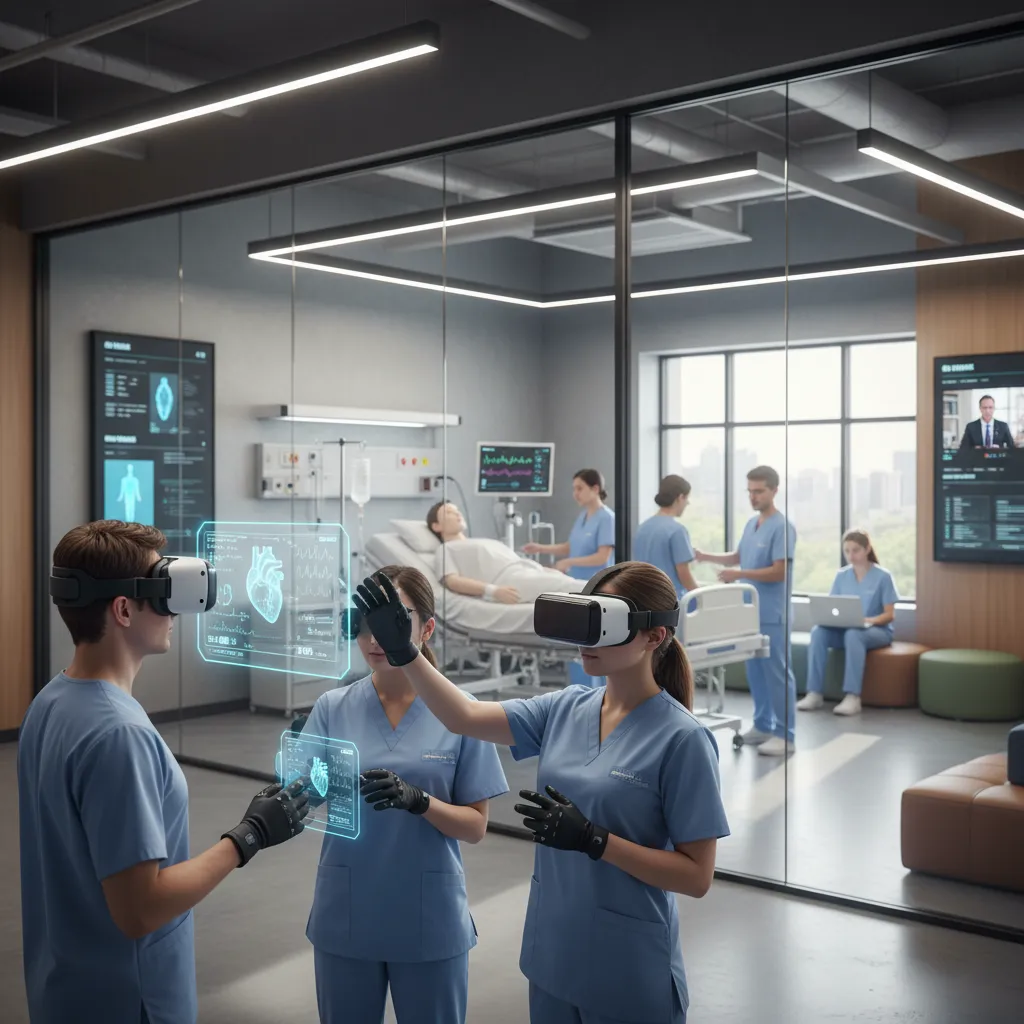Trends in Nursing Education: Simulation, VR and Hybrid Learning
Nursing education has been evolving rapidly to keep pace with advances in technology, shifting healthcare demands, and changing student expectations. Traditional classroom lectures and clinical rotations are no longer enough to prepare students for the complexities of modern healthcare systems. Today, a blend of simulation, virtual reality (VR), and hybrid learning models are transforming how nurses learn and apply their knowledge. These methods not only provide more realistic training but also make education more accessible, flexible, and effective. In this article, we will explore the major trends in nursing education, focusing on simulation-based learning, VR integration, and hybrid learning, and how they collectively shape the future of the nursing profession.

1. Historical Overview of Nursing Education
Nursing education has its roots in apprenticeship-style training, where students learned directly from experienced nurses in hospitals. While this model emphasized hands-on practice, it lacked a structured theoretical foundation. The 20th century brought significant changes with the introduction of university-based nursing programs, emphasizing academic learning alongside clinical practice.
Over time, nursing schools recognized the limitations of relying solely on clinical placements due to limited availability, patient safety concerns, and variations in patient cases. This need for standardization and enhanced learning opportunities paved the way for simulation-based education, which offers consistent and repeatable clinical scenarios in a safe environment.
By understanding this evolution, it becomes clear why the integration of VR and hybrid models is the natural next step in advancing nursing education.
2. The Rise of Simulation in Nursing Education
Simulation has become a cornerstone of modern nursing education. It allows students to practice clinical skills, decision-making, and teamwork in a controlled environment. Unlike traditional classroom teaching, simulation immerses students in realistic scenarios that mimic actual patient care.
High-fidelity mannequins are commonly used in simulation labs. These mannequins can simulate vital signs, bleeding, breathing difficulties, and even communication. Students practice procedures like administering medication, performing CPR, or managing emergencies.
Simulation-based learning ensures that students are better prepared for clinical rotations and practice. It bridges the gap between theory and real-world application while ensuring patient safety by minimizing risks during training.
3. Types of Simulation in Nursing Training
Simulation in nursing education comes in various forms, each serving different educational purposes.
High-Fidelity Simulation
This involves advanced mannequins capable of responding to interventions. For example, students can administer drugs and see immediate physiological changes in the mannequin.
Low-Fidelity Simulation
These are simpler tools such as task trainers used to practice basic procedures like inserting IV lines or checking blood pressure.
Standardized Patients
Actors trained to portray real patients provide opportunities for students to develop communication and empathy skills.
By combining these methods, educators can create a comprehensive and layered training experience that prepares students for both technical and interpersonal aspects of nursing.
4. The Integration of Virtual Reality (VR)
The adoption of virtual reality (VR) in nursing education is transforming the way students experience learning. Unlike simulation mannequins, VR immerses students in fully digital, interactive environments. Using VR headsets, nursing students can practice procedures in virtual hospitals, interact with digital patients, and navigate complex clinical situations.
VR is particularly valuable for rare or high-risk scenarios that students might not encounter frequently in real clinical placements. For example, VR can simulate a mass casualty event or a cardiac arrest emergency, allowing students to rehearse their responses without risk.
Moreover, VR enhances student engagement. The gamified nature of VR learning increases motivation and helps students retain knowledge more effectively.
5. Benefits of VR in Nursing Education
The integration of VR into nursing education offers a wide range of benefits:
- Accessibility: Students can train anytime, anywhere, reducing dependency on physical labs.
- Standardization: Every student experiences the same clinical scenario, ensuring equal training opportunities.
- Immersive learning: The 3D environments mimic real-world clinical settings, promoting deeper understanding.
- Safe environment: Mistakes in VR do not harm real patients, allowing students to learn from trial and error.
In addition, VR prepares students for interprofessional collaboration. Multi-user VR platforms allow nursing students to interact with medical, pharmacy, and other healthcare students in shared simulations, fostering teamwork.
6. Hybrid Learning in Nursing Education
Hybrid learning combines traditional classroom instruction with online and technology-enhanced learning. In nursing, hybrid programs offer flexibility for students who may already be working professionals or managing personal commitments.
For example, theoretical courses such as anatomy, pharmacology, or ethics may be delivered online, while clinical skills are taught through simulation labs and in-person training. This approach provides the best of both worlds: the convenience of online learning and the hands-on practice essential to nursing.
Hybrid learning models gained momentum during the COVID-19 pandemic, but they have since become a permanent feature of many nursing programs due to their effectiveness.
7. Advantages of Hybrid Models
Hybrid learning provides unique advantages for nursing students:
- Flexibility: Students can access lectures and materials online at their convenience.
- Personalization: Online platforms often offer adaptive learning paths tailored to individual progress.
- Resource efficiency: Schools can maximize limited simulation labs by complementing them with online practice.
- Work-life balance: Many nursing students are working professionals; hybrid models support their schedules.
This approach has also improved diversity in nursing education by enabling students from different regions and backgrounds to participate in programs without relocating.
8. Challenges and Limitations of New Learning Models
While simulation, VR, and hybrid learning offer many benefits, they also come with challenges.
Simulation Challenges
High-fidelity mannequins and simulation labs require significant financial investment and maintenance. Smaller institutions may struggle to provide these resources.
VR Limitations
VR technology is still developing. High-quality VR headsets and software can be costly, and not all students have access to the required equipment. Additionally, some students may experience motion sickness or fatigue when using VR for extended periods.
Hybrid Learning Concerns
Hybrid learning requires strong self-discipline. Students must manage their time effectively to balance online coursework with practical training. Some learners may also feel less connected to instructors and peers.
Despite these challenges, ongoing innovation and investment are helping to overcome these limitations.
9. Future Trends in Nursing Education
Looking ahead, nursing education is expected to integrate even more advanced technologies and approaches.
- Artificial Intelligence (AI): AI-powered platforms can provide personalized feedback and identify student weaknesses.
- Augmented Reality (AR): Unlike VR, AR overlays digital information onto real environments, enhancing hands-on training.
- Wearable Technology: Devices like smartwatches and biometric trackers can be used in simulations to teach students about patient monitoring.
- Global Collaboration: Virtual classrooms and simulations can connect nursing students across the globe, promoting cultural competence.
The future will likely bring an increasingly student-centered approach, with technology serving as a tool to enhance—not replace—human instruction and mentorship.
10. Best Practices for Implementing Simulation, VR, and Hybrid Learning
For nursing schools and educators, successful integration of these technologies requires careful planning.
Training Educators
Faculty must be trained not only to use new tools but also to integrate them effectively into curricula.
Ensuring Accessibility
Institutions should provide affordable or shared access to VR headsets, simulation labs, and online platforms.
Student Support
Hybrid learning environments should include robust academic and technical support systems.
Continuous Evaluation
Regular feedback from students and faculty can help refine and improve these methods over time.
By following these best practices, nursing programs can maximize the benefits of simulation, VR, and hybrid learning while addressing their challenges.
Conclusion
The landscape of nursing education is undergoing a profound transformation. With the integration of simulation-based training, virtual reality applications, and hybrid learning models, nursing students are better equipped to meet the challenges of modern healthcare. These approaches provide safe, standardized, and immersive learning experiences while offering flexibility for diverse learners.
Although challenges such as cost and accessibility remain, the continued advancement of technology promises to make these methods more widespread and effective. As nursing education embraces innovation, the ultimate beneficiaries will be not only the students but also the patients who receive safer, more competent, and compassionate care. The future of nursing education is here, and it is powered by technology-driven learning.











